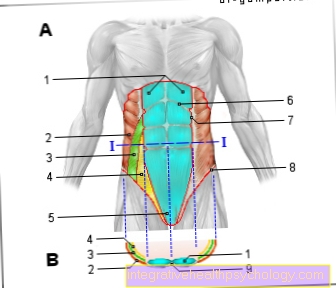Training principles
definition
Training principles are defined as the laws of athletic training with the highest possible general validity. Training principles are often described as training maxims and principles.

Training principles are therefore higher-level instructions for practical training, but not to be equated with specific training guidelines.
The most important training principles:
- Principle of the effective stress stimulus
- Principle of progressive loading
- Principle of exercise and recovery
- Principle of periodization
Notice!
Training principles are based on the principles of training theory and do not have a scientifically sound basis.
Classification of the training principles
Different authors of training science use different classifications of training principles.
Usually the division is made into:
- Pedagogical and didactic principles
- Training principles from the theory and practice of motor performance development.
Another common breakdown from the literature divides the training principles into:
- Training principles of stress and triggering adjustment symptoms
- Training principle of the effective stress stimulus
- Training principle of progressive increase in load
- Training principle of the variation of the training load
- Training principles of cycling to ensure adaptation
- Training principle of optimal design of stress and recovery
- Training principle of repetition and continuity
- Training principle of periodization and cyclization
- Training principles of specialization to specify training
- Training principle of individuality and age
- Training principle of increasing specialization
- Training principle of the regulating interaction of individual training elements
The principle of. Is of particular importance for the creation of training plans in training practice effective stress stimulus, the principle of progressive load, the principle of optimal design of stress and recovery and the principle of Periodization and cyclization.
The individual training principles briefly explained
1. The principle of the effective stress stimulus
This training principle is based on the adaptation symptoms triggered by athletic training. Only a sufficiently strong training stimulus (supra-threshold stimulus) leads to the desired adaptation of the organism.
In short: only those who train sufficiently intensively improve their performance.
more on the subject Principle of the effective stress stimulus
2. Principle of progressive loading
Progressive load is understood as the continuous, adaptation-related increase in the training load.
In short: those who train a lot improve their performance, improved performance requires higher training stimuli.
more on the subject Principle of progressive loading.
3. Principle of varying the training load
New / different stimuli trigger new symptoms of adaptation. In training, therefore, stimuli that are as variable as possible should be used. This applies not only to training content but also to training methods.
in short: not just Maximum strength train, rather isolated also stimuli for hypertrophy or strength endurance.
Not just running, but also cycling, swimming ...
Variation stimulates business
4. The principle of optimal design of exercise and recovery
Adaptation processes take place in the regeneration phase. The phases between the individual training units thus play an important role in training practice. Only sufficient regeneration leads to an increased functional state.
more on the subject Principle of optimal design between exercise and relaxation
5. Principle of repetition and continuity
Sports success only comes with time. This principle includes sustainable, long-term and systematic training
in short: only those who train long-term can achieve and maintain the desired success.
6. Principle of periodization and cyclization
The principle of periodization and cyclization organizes the training in a certain period of time in several periods. The aim is to develop the optimal athletic form at a certain time.
In short: The aim of marathon preparation is to achieve the optimal form of training at the time of the marathon.
More on the subject: Principle of periodization and cyclization
7. Principle of individuality and age
Individual requirements require individual training plans. Age-appropriate planning and implementation of training is the basis for long-term health-oriented sport.
In short: Older people should primarily prefer sports that do not contain any fast-acting or reactive elements.
8. Principle of increasing specialization
Sports training in relation to competition preparation should take place according to the principle of increasing specialization from general to specific. Both in the conditional, coordinative and cognitive, an increasing sport-related orientation is understood.
9. Principle of the regulating interaction of individual training elements
What is meant here is the optimal change between the individual training units of conditional and technical skills and abilities.
This interaction is particularly important in sports practice with regard to the negative influence on individual training elements.
In short: aerobic endurance training can have a negative effect on sprinting ability
Training principles in endurance sports
Basically, the same training principles apply to effective training, but these must be specifically adapted to the requirements depending on the sport.
The training plan and the training unit are based on the general training conditions but must always be tailored to the user. Here, for example, the current performance beach is taken into account. Was the person exercising just sick, is there a heavy load in the coming days, how old is the person being exercised ...? The training principles in endurance sports can be interpreted as follows.
- Principle of the effective training stimulus
- Principle of individual load adjustment
- Principle of increasing stress stimulus
- The principle of the correct loading sequence
- Principle of varying loads
- Principle of changing loads
- Principle of optimal regeneration
Read more on the topic: How can you improve endurance?
Principle of the effective training stimulus
This is about the effectiveness of the training.
Stimuli that are set too low or always the same stimuli will at some point no longer be seen as a challenge by the body through adaptation and the training success will stagnate.Too intense stimuli can lead to fatigue and excessive demands and also hinder training success. For endurance sports this means adjusting the desired time or the running distance so that an effective training stimulus can be set.
Principle of individual load adjustment
This means the adaptation of the training to the level of performance of the individual.
Here is an example: An endurance athlete who is at the beginning of his running career will first start with distance runs, for example 3-5 km (depending on the basic level of training), while an experienced runner would start his season strong with an extensive 10 km run. This principle is about picking up the trainee at their current level.
You might also be interested in this topicn: The fitness bracelet
Principle of increasing stress stimulus
This principle builds heavily on the first principle.
In endurance training, the body adapts to the training stimulus. So in order to get an improvement in the level of performance, the stimulus must be increased (to remain effective). The training frequency (3x instead of 2x / week), the distance (10 instead of 7km), or the pace (6: 10min / km instead of 6: 45min / km) are the adjusting screws to adjust a stress stimulus.
Read more on the topic: Training principle of the progressive stress stimulus
Principle of the correct loading sequence
This principle plays a less important role in pure endurance training, since endurance training usually does not combine different motor qualities (strength, flexibility, speed).
Basically, coordination exercises and speed training, if they are included in the endurance plan, should always precede the actual endurance performance (after the warm-up) in order to be able to train the muscles effectively before fatigue.
Principle of varying loads
This principle is particularly important if you want to set new stimuli after a long training period in order to increase the training success again.
If you have trained running as an endurance performance through forest runs for a season, you can, for example, perform endurance-promoting interval training on the sports field to offer the body a new stimulus.
Principle of optimal regeneration
A training stimulus can only lead to successful adaptation if the body is given sufficient time to recover after a session. This includes rest for the muscles, but also supplying the body with nutrients and mental relaxation.
Regeneration phases should also be observed in endurance sports, on the other hand, injuries (e.g. knee problems from daily endurance running) and severe fatigue or motivation problems can occur.
Read more on the topic: Recovery and stress
Training principles in weight training
The above training principles also apply to weight training. However, here are some pre-made principles and training plans that can help you follow the principles.
In order to achieve an effective training stimulus, the weights should not be increased directly at the beginning, but first the number of repetitions should be increased (from 8 to 12), then another set (initially 3 then 4 sets) can be added. Only when this change no longer brings any progress should the weight be increased so that again only 8 repetitions in 3 sets are possible.
Read more on the topic: The best strength training exercises
The individual adaptation of the training is also extremely important in weight training. The weights should be tailored to the user.
In order to follow the principle of variation, different exercises can be performed for certain muscle groups. Changing exercise equipment can give your workout a boost.
Different forms of training can be used as a changing load. Examples are HIIT, superset or circuit training.
Choosing the right load sequence plays a bigger role in strength training, especially when different forms of strength are to be trained. Technique / coordination and maximum strength training should always take place immediately after warming up to avoid injuries, strength endurance follows afterwards.
Even in weight training, the body should be given sufficient time to regenerate. For this purpose, the Split Plan, for example, provides for intensive training of a certain muscle group 1-2 times a week, on the following days this group can recover and another muscle group is trained, so a sufficient break between the loads is guaranteed .
Read more on the topic: Building Muscle - Effective Exercises





























